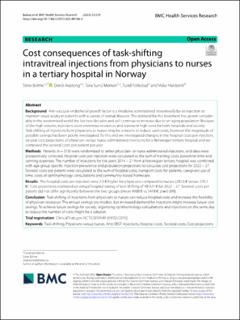| dc.contributor.author | Bolme, Stine | |
| dc.contributor.author | Austeng, Dordi Kristine | |
| dc.contributor.author | Morken, Tora Sund | |
| dc.contributor.author | Follestad, Turid | |
| dc.contributor.author | Halsteinli, Vidar | |
| dc.date.accessioned | 2023-10-11T10:31:27Z | |
| dc.date.available | 2023-10-11T10:31:27Z | |
| dc.date.created | 2023-03-31T12:28:25Z | |
| dc.date.issued | 2023 | |
| dc.identifier.issn | 1472-6963 | |
| dc.identifier.uri | https://hdl.handle.net/11250/3095763 | |
| dc.description.abstract | Background
Anti-vascular endothelial growth factor is a medicine administered intravitreally by an injection to maintain visual acuity in patients with a variety of retinal diseases. The demand for this treatment has grown considerably in the westernized world the last two decades and will continue to increase due to an aging population. Because of the high volume, injections seize enormous resources and represent high costs for both hospitals and society. Task-shifting of injections from physicians to nurses may be a means to reduce such costs, however the magnitude of possible savings has been poorly investigated. To this end we investigated changes in the hospital costs per injection, six-year cost projections of physician- versus nurse-administered injections for a Norwegian tertiary hospital and we compared the societal costs per patient per year.
Methods
Patients (n = 318) were randomized to either physician- or nurse administered injections, and data were prospectively collected. Hospital costs per injection were calculated as the sum of training costs, personnel time and running expenses. The number of injections for the years 2014 – 21 from a Norwegian tertiary hospital was combined with age group specific injection prevalence and population projections to calculate cost projections for 2022 – 27. Societal costs per patient were calculated as the sum of hospital costs, transport costs for patients, caregivers’ use of time, costs of ophthalmology consultations and community-based homecare.
Results
The hospital costs per injection were 5.5 € higher for physicians compared to nurses (281.6 € versus 276.1 €). Cost projections estimated an annual hospital saving of task-shifting of 48 921 € for 2022 – 27. Societal costs per patient did not differ significantly between the two groups (mean 4988 € vs 5418 €, p = 0.398).
Conclusion
Task-shifting of injections from physicians to nurses can reduce hospital costs and increase the flexibility of physician resources. The annual savings are modest, but increased demand for injections might increase future cost savings. To achieve future savings for society, organizing ophthalmology consultations and injections on the same day to reduce the number of visits might be a solution. | en_US |
| dc.language.iso | eng | en_US |
| dc.publisher | BioMed Central Ltd | en_US |
| dc.rights | Navngivelse 4.0 Internasjonal | * |
| dc.rights.uri | http://creativecommons.org/licenses/by/4.0/deed.no | * |
| dc.title | Cost consequences of task-shifting intravitreal injections from physicians to nurses in a tertiary hospital in Norway | en_US |
| dc.title.alternative | Cost consequences of task-shifting intravitreal injections from physicians to nurses in a tertiary hospital in Norway | en_US |
| dc.type | Peer reviewed | en_US |
| dc.type | Journal article | en_US |
| dc.description.version | publishedVersion | en_US |
| dc.source.volume | 23 | en_US |
| dc.source.journal | BMC Health Services Research | en_US |
| dc.identifier.doi | 10.1186/s12913-023-09186-0 | |
| dc.identifier.cristin | 2138849 | |
| dc.source.articlenumber | 229 | en_US |
| cristin.ispublished | true | |
| cristin.fulltext | original | |
| cristin.qualitycode | 2 | |

